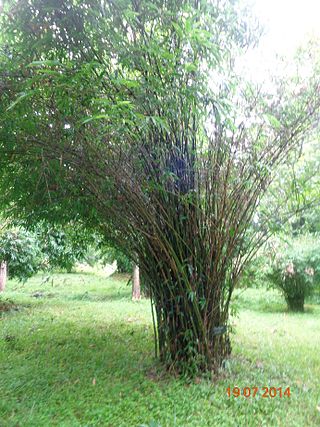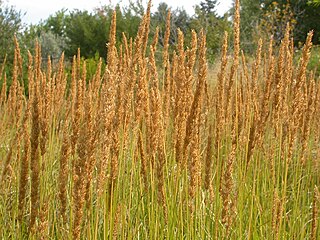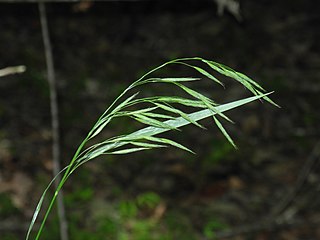
Arundinaria is a genus of bamboo in the grass family the members of which are referred to generally as cane. Arundinaria is the only bamboo native to North America, with a native range from Maryland south to Florida and west to the southern Ohio Valley and Texas. Within this region Arundinaria canes are found from the Coastal Plain to medium elevations in the Appalachian Mountains.

Bambusa tulda, or Indian timber bamboo, is considered to be one of the most useful of bamboo species. It is native to the Indian subcontinent, Indochina, Tibet, and Yunnan, and naturalized in Iraq, Puerto Rico, and parts of South America.

Calamagrostis stricta, known as slim-stem small reed grass or narrow small-reed, is a species of bunchgrass in the family Poaceae of the Holarctic Kingdom.

Dendrocalamus strictus is a bamboo species belonging to the Dendrocalamus genus. The culms (stems) are often solid. Common names include male bamboo, solid bamboo, and Calcutta bamboo.

Bambusa bambos, the giant thorny bamboo, Indian thorny bamboo, spiny bamboo, or thorny bamboo is a species of clumping bamboo native to southern Asia. It is also naturalized in Seychelles, Central America, West Indies, Java, Malaysia, Maluku, and the Philippines.

Arundinaria gigantea is a species of bamboo known as giant cane, river cane, and giant river cane. It is endemic to the south-central and southeastern United States as far west as Oklahoma and Texas and as far north as New York. Giant river cane was economically and culturally important to indigenous people, with uses including as a vegetable and materials for construction and craft production. Arundinaria gigantea and other species of Arundinaria once grew in large colonies called canebrakes covering thousands of acres in the southeastern United States, but today these canebrakes are considered endangered ecosystems.

Phyllostachys bambusoides, commonly called madake, giant timber bamboo, or Japanese timber bamboo, is a species of flowering plant in the bamboo subfamily of the grass family Poaceae, native to China, and possibly also to Japan.

Dendrocalamus hamiltonii, or Hamilton's bamboo, is a species of bamboo, 12–15 cm in diameter and growing up to 15–18 m in height, found in South Asian countries such as, India, Sri Lanka, Bhutan, Nepal, Pakistan, and far eastern China.
Festuca actae is a species of grass which can be found in New Zealand.
Dendrocalamus giganteus, commonly known as giant bamboo, is a giant tropical and subtropical, dense-clumping species native to Southeast Asia. It is one of the largest bamboo species in the world.

Ochlandra stridula, the Ceylon reed-bamboo, reed bamboo or forest bamboo, is a species of bamboo in the grass family). It is endemic to Sri Lanka. It can be found extensively in Ratnapura and Kegalle districts, in waste lands of rainforest and also along stream banks and in forest gaps.
Neololeba atra, the black bamboo, is a species of tropical Asian, Australian, and Papuasian bamboos in the grass family Poaceae.
Dendrocalamus longispathus, the long-sheath bamboo, is a bamboo species which grows up to 20 m tall. It is native to Bangladesh, Myanmar, and Thailand. It has now become an exotic species all over the South Asia.

Gigantochloa atter, the black bamboo, sweet bamboo, or giant atter, is a bamboo species belonging to the genus Gigantochloa. It grows up to 20 m tall. It is native to Island Southeast Asia, but has become naturalized all over the South Asia.

Thyrsostachys siamensis is one of two bamboo species belonging to the genus Thyrsostachys. It grows up to 7 to 13m tall. It is native to Yunnan, Myanmar, Laos, Thailand, Vietnam and naturalised in Sri Lanka, Bangladesh, Malaysia. The plant is also known as long-sheath bamboo, monastery bamboo, Thai bamboo, Thai umbrella bamboo, umbrella bamboo, and umbrella-handle bamboo.

A canebrake or canebreak is a thicket of any of a variety of Arundinaria grasses: A. gigantea, A. tecta and A. appalachiana. As a bamboo, these giant grasses grow in thickets up to 24 feet (7.3 m) tall. A. gigantea is generally found in stream valleys and ravines throughout the southeastern United States. A. tecta is a smaller stature species found on the Atlantic and Gulf Coastal Plains. Finally, A. appalachiana is found in more upland areas at the southern end of the Appalachian Mountains. Cane does not do well on sites that meet wetland classification. Instead, canebrakes are characteristic of moist lowland, floodplain areas that are not as saturated as true wetlands.

Arundinaria tecta, or switchcane, is a bamboo species native to the Southeast United States, first studied in 1813. It serves as host to several butterfly species. The species typically occurs in palustrine wetlands, swamps, small to medium blackwater rivers, on deep peat in pocosins, and in small seepages with organic soils. The species is only known to occur in the Atlantic Plain, Gulf Coastal Plain, and Mississippi Embayment, though it was earlier thought to exist in the Piedmont and Southern Appalachians as well. Specimens from the uplands are now thought to be a separate but morphologically similar species, Arundinaria appalachiana.

Chorizandra is a genus of rhizomatous sedges, encompassing six species; four of which are endemic to Australia and two to New Caledonia.

Bromus nottowayanus, the Nottoway Valley brome or satin brome, is a brome grass native to North America. The specific epithet nottowayanus refers to the Nottoway Valley. The grass has a diploid number of 14.

Arundinaria alabamensis is bamboo species commonly known as Tallapoosa cane. The plant species is endemic to Alabama and is primarily found in the east-central part of the State, mainly the Piedmont Upland physiographic province. Currently, A. alabamensis is the 4th species of native bamboo in the USA.

















